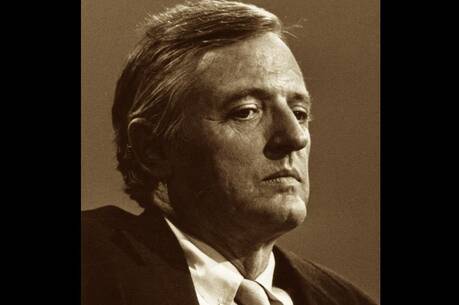Review: Treating the spiritual life like an adventure
In his new book, Seeing With the Heart: A Guide to Navigating Life’s Adventures, Kevin O’Brien, S.J., thoughtfully crafts a true guide for living a life of compassion, meaning and depth. The book provides a reflective pause to holistically look at our lives, with all of their twists and turns of grace and challenge, and consider how we are living in relationship to ourselves, others and the divine.
O’Brien shares his great knowledge of the Spiritual Exercises of St. Ignatius in an approachable way for an expansive audience, weaving in poetry, Scripture and stories from his own life and those of others. The book is ultimately an invitation to live, as St. Ignatius writes, with magnanimity, inspiring us to be “great-souled” people attentive to the needs of others, clear in our integrity, rooted in hope and as “beholders of the holy.”
Seeing With the Heart is composed in a way that facilitates reflection, presenting key themes of moving through life as a pilgrim: living with purpose, living the questions, living with depth, living in freedom, living out of great desires, living with compassion, living in hope and living with discernment. At the end of every chapter, O’Brien provides brief spiritual exercises: reflection questions and prompts to integrate the substance of the chapters into the particulars of one’s life.
O’Brien shares his knowledge of the Spiritual Exercises of St. Ignatius in an approachable way, weaving in poetry, Scripture and stories from his own life and those of others.
An invitation of the book is not only to intentionality, but to joy. O’Brien writes, “Joy comes when we live out of the deepest sense of who we are, when we let God and others come close, when we offer our lives in the service of others, when we rest in the stillness and beauty of our world.” The invitation to live deliberately and wholeheartedly is a pathway not necessarily to ease but surely to joy, because we keep our gaze on purpose, as expressed in the First Principle and Foundation at the start of the Spiritual Exercises.
O’Brien writes that living with purpose entails living with attentiveness—that is, “attention both to where we are walking and to the distant horizon: not so focused on our end that we miss out on what is right around us, not so focused on what’s around us that we lose sight of the end that keeps us on track.” A purposeful life trusts in the solid ground of deep commitment and conviction, even when the path is rocky or the road windy.
A few years ago I established a holistic wellness practice called Presence and Reverence, so a favorite part of the book for me is the section on cultivating a sacramental imagination, something that indeed requires both presence and reverence. Our imagination and attentiveness to even the most ordinary of things can bring forth awareness of the sacred in our midst. O’Brien writes, “Seeing with the heart, everything shimmers brilliantly—if we are open to it. Golden wheat blowing in the wind. Water running over dishes. A sun setting across a ballpark.” If we notice and delight in the mundane, ordinary moments can become transcendent.
O’Brien asserts that with delight comes duty: “We treat people with dignity and we reverence God’s creation.” Our Creator is calling out to us at all times, hoping to catch our attention to perhaps just rest for a moment in beauty, and also to not be the same because of it. We are invited “to come into the peace of wild things” and “rest in the grace of the world,” as Wendell Berry has written, and also to labor for a more just and gentle world. A life devoted to holy mystery does not separate these out, but lives both as one call.
The duty, O’Brien writes, is to a life of compassion. O’Brien points to Pope Francis’ vision of a church of encounter, one which is “bruised, hurting and dirty because it has been out on the streets, rather than a Church which is unhealthy from being confined and clinging to its own security.” Encounter risks closeness to another’s chaos and demonstrates the power of tenderness in a world so far from being tender. O’Brien pulls the word splagchnizomai from the Gospels, a word that describes a physical, deep response, that we find when Jesus encounters someone in need—the word used when the father sees his younger son approaching home in the story of the prodigal son, and again in the story of the good Samaritan, when the Samaritan traveler is deeply moved at the sight of a stranger in pain.
It is this kind of compassion that flows from integrated reverence and this kind of compassion that ultimately makes us more human and brings our world closer in kinship. O’Brien underscores upholding others’ dignity and striving toward solidarity with the marginalized as concrete steps toward a “revolution of tenderness,” to quote Pope Francis.
O’Brien includes the insight of Richard Rohr, O.F.M., that “healers who have fully faced their wounds are the only ones who heal anyone else.”
The text, subtitled “A Guide to Navigating Life’s Adventures,” does not gloss over the real pain, suffering and loss that we encounter in our lifetime. He appreciates that there are real reasons for lament in our individual lives and in the world in which we find ourselves. Living with depth does not skirt around pain but cries out knowing it with rawness. We weep as Jesus did. Love opens us up to pain, and “love does not run,” as O’Brien writes. Love sometimes looks like grief, for grief is love-preserving.
O’Brien includes the insight of Richard Rohr, O.F.M., that “healers who have fully faced their wounds are the only ones who heal anyone else.” Perhaps we might hold our pain or loss or grief with the same reverence with which we would gaze upon wild geese flying overhead on a misty morning—all wrapped up in greater mystery. We hold onto the promise that in death life is changed, not ended. Hope is the virtue of the pilgrim, O’Brien writes; resurrection will follow and hope will come. It is our promise.
Insights on discernment, a great gift and always-relevant tool offered to us by St. Ignatius, are an essential part of O’Brien’s text. “Ignatian discernment is a sturdy rudder that allows us to navigate the various currents on our pilgrim journey,” he writes, “and to become ‘in sync’ with God’s gracious outreach.”
As a spiritual director, I will be sharing O’Brien’s chapter on discernment with directees and colleagues for years to come. He shares wisdom and practical advice for understanding Ignatian writings on the discernment of spirits, making decisions and growing in spiritual awareness. He imparts that in living with discernment, our unique destinations are revealed rather than dictated: “We do our best to follow God’s lead, and then we trust that God is with us, wherever we land. God, who is generous and creative, will get us where we need to go, even if by a circuitous route.”
Seeing With the Heart is a gift to all of us on the journey. It is a book to keep on our nightstand and send to a friend, for it inspires a real look at our living and a prod to authenticity and wholeness—not only for ourselves but for the healing of our world. It is a treasure of a guide to hold close on our journey, as we move toward, in O’Brien’s words, “that loving Mystery which summoned us all along.”
This article also appeared in print, under the headline “Beholders of the Holy,” in the January 2024, issue.











